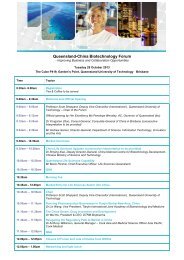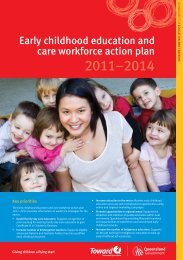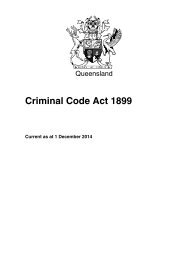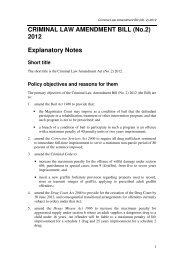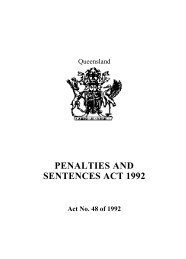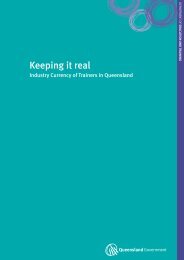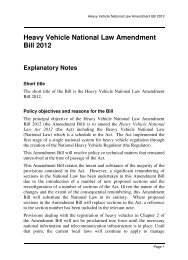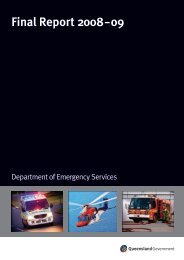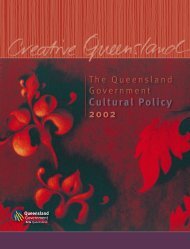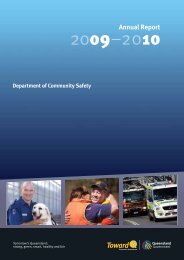Queensland Life Sciences Industry Report 2012 (PDF, 3.5MB)
Queensland Life Sciences Industry Report 2012 (PDF, 3.5MB)
Queensland Life Sciences Industry Report 2012 (PDF, 3.5MB)
Create successful ePaper yourself
Turn your PDF publications into a flip-book with our unique Google optimized e-Paper software.
<strong>Queensland</strong> <strong>Life</strong> <strong>Sciences</strong> <strong>Industry</strong> <strong>Report</strong> <strong>2012</strong><br />
14<br />
Profile of Research Organisation Respondents<br />
Research organisations who responded to the survey<br />
included research institutes (50%), research centres<br />
(29%), faculties (11%), university research offices<br />
responding for the university as a whole (7%) and<br />
schools (4%).<br />
The greatest concentration of research activities<br />
undertaken by research organisations (62%) was<br />
across the five segments of the Human Health<br />
sub-sector. 4<br />
2.5 Employment, Education and Skilling<br />
Survey participants employed 8085 full time equivalent<br />
(FTE) persons in <strong>Queensland</strong>, with 3433 (42%) of those<br />
employed by companies5 . Among surveyed companies,<br />
the complementary medicines sector was the largest<br />
employer with 37.6% of FTEs reported.<br />
35% of staff were employed as R&D professionals or in<br />
other technical and R&D support roles.<br />
The average salary of QLS <strong>Industry</strong> employees was<br />
estimated at $66,965 compared to an average across <strong>Life</strong><br />
<strong>Sciences</strong> roles in Australia of $74,750 and an average<br />
national wage of $71,568 (derived from various ABS data<br />
sources — see 14.4.3).<br />
Research organisations reported that, on average, 47.3%<br />
(median 42.5%) of their workforce held a PhD. An average<br />
of 19% (median 4%) of staff in companies held a PhD.<br />
Over the next five years, the most commonly anticipated<br />
skills gaps were in (1) business development; (2)<br />
commercialisation; and (3) chemistry.<br />
2.6 Income and Expenditure<br />
Respondents generated a combined income of $1995<br />
million in 2011.<br />
Companies reported that 95.2% of their income was<br />
sourced from the sale of goods and services with only<br />
1.5% from grants. By contrast, research organisations<br />
reported 8.2% of their income was sourced from the sale<br />
of goods and services and 79.5% from grants.<br />
The majority of companies (56.3%) and research<br />
organisations (63.0%) reported income growth in 2011.<br />
On average, company income grew by 14.9% (median 3%)<br />
and research organisations income by 19% (median 4%).<br />
One fifth of company respondents did not answer this<br />
question.<br />
A total of $594 million in grant income was received by<br />
survey participants in 2011, with research organisations<br />
accounting for $580 million (97.6% by value) and<br />
companies $14 million (2.4%).<br />
Companies were awarded $27.2 million in new grant<br />
funding during 2011, with $13.6 million of this funding<br />
being actually received in the same year6 .<br />
Respondents reported total expenditure of $1091 million<br />
with $564 million spent on wages and salaries (52%),<br />
$189 million on R&D (17%) and $134 million on capital<br />
items (12%).<br />
Respondents from the Human Health – Pharmaceuticals,<br />
vaccines or drug discovery sub-sector reported the<br />
highest average spend on R&D of all industry<br />
sub-sectors.<br />
Research Organisations accounted for 74% of the capital<br />
expenditure reported for 2011.<br />
2.7 Sentiment and Outlook<br />
Business sentiment was positive overall with 65% of<br />
respondents expecting their income to increase over the<br />
coming 12 months and 82% of respondents expecting<br />
their income to increase over the next three years.<br />
While the majority of companies and the majority of<br />
research organisations expected income growth over<br />
12 months and three years, about 13% of companies<br />
anticipated a decrease in total income over the next<br />
12 months and 6% anticipated a decrease in total income<br />
over the next three years. By contrast, no research<br />
organisations anticipated a fall in income in either period.<br />
The average expected quantum change in income for<br />
companies over the coming 12 months was 47% and for<br />
research organisations, 8%. Over the next three years the<br />
forecast quantum change in income for companies was<br />
136% and for research organisations, 18%.<br />
An almost equal proportion of companies anticipated<br />
that their R&D expenditure would either increase or<br />
remain the same over the coming 12 months (42%<br />
remain the same, 45% increase) and three years (44%<br />
remain the same, 45% increase). The majority of research<br />
organisations anticipated that their R&D expenditure<br />
would increase over the coming 12 months (56%) and<br />
three years (83%).<br />
Respondents believed that improved industry<br />
representation and an increased commitment by<br />
government organisations to become early adopters of<br />
<strong>Queensland</strong> innovations were two factors important for<br />
future expansion of the industry.<br />
For 71% of companies, limited access to finance was<br />
having an impact on their organisation. While 43% of<br />
companies (96) were optimistic or very optimistic that<br />
this barrier could be overcome, 19% were pessimistic or<br />
very pessimistic. Other barriers to future income growth<br />
that were highly ranked included (1) limited access to<br />
government grant funding (grants accounted for only 1.5%<br />
of company income, and companies attracted only 2.4% of<br />
the value of all grants reported in the survey);<br />
(2) increased domestic and/or international competition;<br />
and (3) the small size of the domestic market.<br />
The three greatest risks or challenges facing respondents<br />
were (1) access to sufficient capital for growth or market<br />
entry; (2) the high Australian dollar; and (3) regulatory<br />
issues.<br />
4 Ibid.<br />
5 Excluding persons paid by commission only, consultants or contractors, non-salaried directors and volunteers.<br />
6 Note that many grants are awarded for periods covering 2-3 years and, as such, the amount awarded may not be counted as income in the year that it<br />
was awarded.



